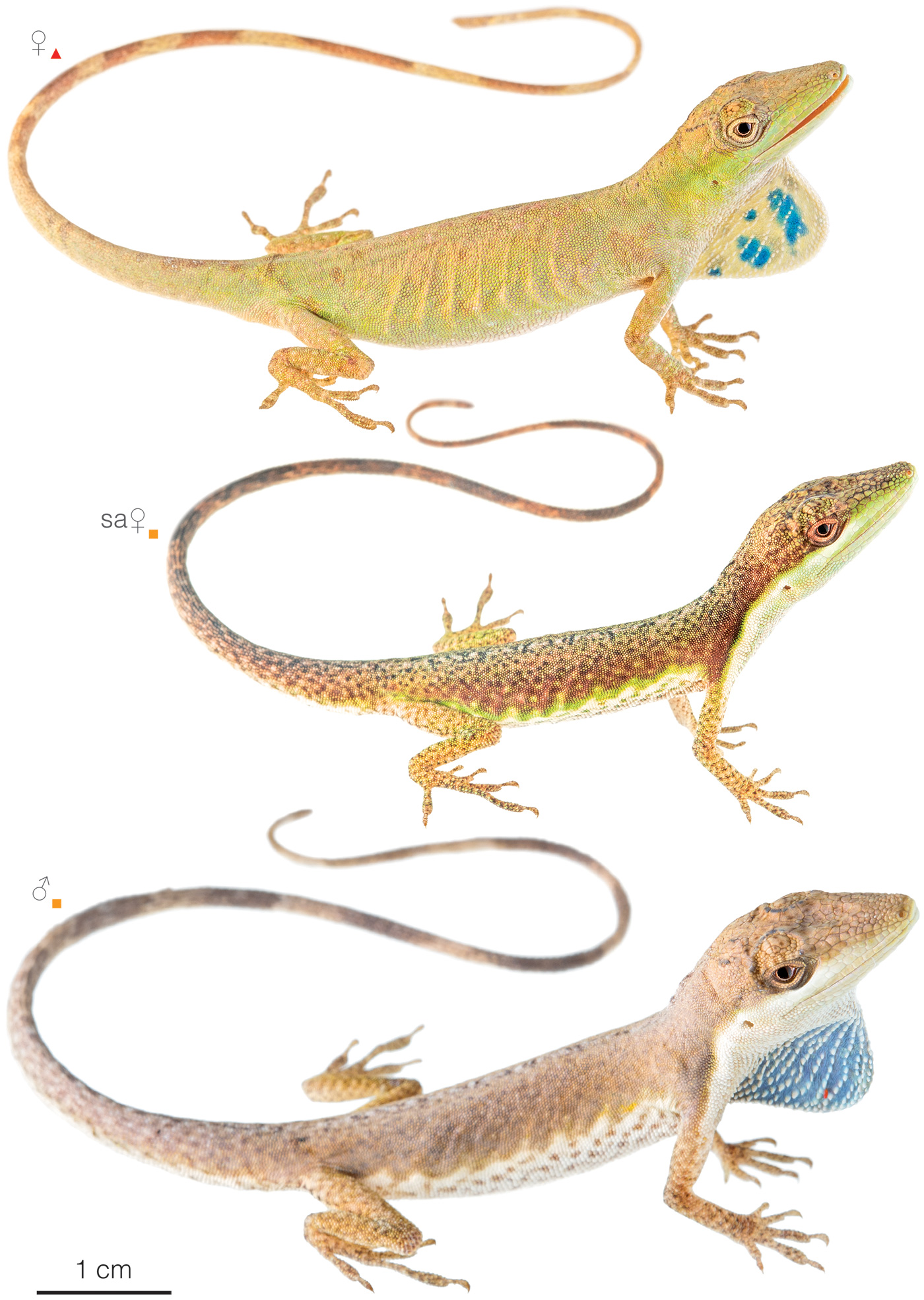Published May 22, 2023. Open access. | Purchase book ❯ |
Blue-Dewlap Anole (Anolis hyacinthogularis)
Reptiles of Ecuador | Sauria | Anolidae | Anolis hyacinthogularis
English common name: Blue-Dewlap Anole.
Spanish common name: Anolis de saco azul.
Recognition: ♂♂ 18.7 cmMaximum distance from the snout to the tip of the tail. Snout–vent length=5.7 cm. ♀♀ 17.5 cmMaximum distance from the snout to the tip of the tail. Snout–vent length=5.2 cm..1,2 Anoles are easily distinguishable from other lizards by their diurnal habits, extensible dewlap in males (can be present in females also), expanded digital pads, and granular scales on the dorsum and belly.3,4 The Blue-Dewlap Anole (Anolis hyacinthogularis) can be identified from other co-occurring anoles based on its small body size, long tail (about 2.4x SVL), smooth head scales, and small blue dewlap.2 In males, the dewlap is sky blue with horizontal rows of whitish cream scales; in females, it is cream with blue irregular blotches (Fig. 1). The only other anole with a blue dewlap in eastern Ecuador is A. bombiceps, but this species occupies a different altitudinal gradient.5

Figure 1: Individuals of Anolis hyacinthogularis from Ecuador: Captación de Hidronormandía, Morona Santiago province (); San Francisco Research Station, Zamora Chinchipe province (). sa=subadult.
Natural history: Anolis hyacinthogularis is a rare diurnal and arboreal lizard that inhabits the understory of old-growth to moderately disturbed cloud forests as well as bamboo patches near the forest border.1,2 All individuals of this species have been found at night, roosting on twigs and narrow leaves 2–4 m above the ground.1,2 These reptiles change their dorsal coloration when disturbed, going from bright pale tan to dark brown.
Conservation: Data Deficient There is inadequate information to make an assessment of extinction risk.. Anolis hyacinthogularis is a recently described species. Therefore, its conservation status has not yet been formally evaluated by the IUCN. Here, it is proposed to be included in the DD category because there is inadequate information to make an assessment of its extinction risk based on its scarce distribution data. The species is only from two localities (Fig. 2) separated from each other by areas having adequate cloud forest cover, suggesting it might be present elsewhere.
Distribution: Anolis hyacinthogularis is endemic to the Amazonian slopes of the Andes in Ecuador. The species has been recorded at elevations between 1441 and 2186 m (Fig. 2).

Figure 2: Distribution of Anolis hyacinthogularis in Ecuador. The star corresponds to the type locality: San Francisco Research Station, Zamora Chinchipe province. See Appendix 1 for a complete list of the presence localities included in the map.
Etymology: The generic name Anolis is thought to have originated from Cariban languages, specifically from the word anoli, which is the name Arawak peoples may have used to refer to this group of lizards.6 The specific epithet hyacinthogularis refers to the blue dewlap of the male and comes from the Latin words hyacinthus (=blue) and gula (=throat).2
See it in the wild: Less than ten individuals of the Blue-Dewlap Anole have ever been reported, suggesting they are either extremely hard to find or their populations are naturally low. At the type locality, San Francisco Research Station, these anoles are easier spotted at night, as they will be roosting on small twigs and leaves where their bright whitish bellies stand out when lit with a flashlight.
Author: Alejandro ArteagaaAffiliation: Fundación Khamai, Reserva Arlequín, Ecoruta Paseo del Quinde km 56, Santa Rosa de Mindo, Pichincha 171202, Ecuador.
Photographers: Jose VieirabAffiliation: Tropical Herping (TH), Quito, Ecuador.,cAffiliation: ExSitu, Quito, Ecuador. and Sebastián Di DoménicodAffiliation: Keeping Nature, Bogotá, Colombia.
How to cite? Arteaga A (2023) Blue-Dewlap Anole (Anolis hyacinthogularis). In: Arteaga A, Bustamante L, Vieira J (Eds) Reptiles of Ecuador: Life in the middle of the world. Available from: www.reptilesofecuador.com. DOI: 10.47051/NJPB8353
Literature cited:
- Field notes, Reptiles of Ecuador book project.
- Torres-Carvajal O, Ayala-Varela FP, Lobos SE, Poe S, Narváez AE (2017) Two new Andean species of Anolis lizard (Iguanidae: Dactyloinae) from southern Ecuador. Journal of Natural History 52: 1067–1089. DOI: 10.1080/00222933.2017.1391343
- Peters JA, Donoso-Barros R (1970) Catalogue of the Neotropical Squamata: part II, lizards and amphisbaenians. Bulletin of the United States National Museum, Washington, D.C., 293 pp.
- Castañeda MR, de Queiroz K (2013) Phylogeny of the Dactyloa clade of Anolis lizards: new insights from combining morphological and molecular data. Bulletin of the Museum of Comparative Zoology 160: 345–398. DOI: 10.3099/0027-4100-160.7.345
- Ayala-Varela F (2004) Revisión taxonómica y de variación geográfica de las especies de Anolis (Sauria: Polychrotidae) del Oriente Ecuatoriano. BSc thesis, Pontificia Universidad Católica del Ecuador, 204 pp.
- Allsopp R (1996) Dictionary of Caribbean English Usage. Oxford University Press, Oxford, 776 pp.
Appendix 1: Locality data used to create the distribution map of Anolis hyacinthogularis in Ecuador (Fig. 2). Go to the section on symbols and abbreviations for a list of acronyms used. Asterisk (*) indicates type locality.
| Country | Province | Locality | Source |
| Ecuador | Morona Santiago | Captación Hidronormandía | This work; Fig. 1 |
| Ecuador | Zamora Chinchipe | San Francisco Research Station* | Torres-Carvajal et al. 2017 |